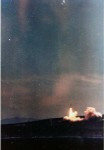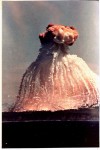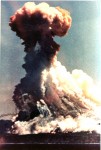Scratch One Spysat
An eyewitness recalls one of history’s great rocket explosions.
:focal(511x385:512x386)/https://tf-cmsv2-smithsonianmag-media.s3.amazonaws.com/filer/fb/91/fb919bcf-bea6-4604-b5ee-730bd9f5bcf3/18-april-1986-7-1024x673.jpg)
![]() The National Reconnaissance Office recently declassified its GAMBIT and KH-9 HEXAGON spy satellite programs, and as part of the agency’s 50th anniversary celebration, allowed a HEXAGON to be displayed — for just one day — at the National Air and Space Museum’s Udvar-Hazy Center in northern Virginia.
The National Reconnaissance Office recently declassified its GAMBIT and KH-9 HEXAGON spy satellite programs, and as part of the agency’s 50th anniversary celebration, allowed a HEXAGON to be displayed — for just one day — at the National Air and Space Museum’s Udvar-Hazy Center in northern Virginia.
A few days later, Lockheed Martin Missiles and Space retiree Art Jesensky wrote to us, “I have enclosed some photos and a story I wrote about the day the last HEXAGON satellite was launched [April 18, 1986]. The pictures were taken by an oil company employee just offshore on an exploration platform.”
Here’s Jesensky’s account:
In April 1986, the space community and media were still reeling from the loss of the space shuttle Challenger and its seven-member crew just three months earlier, so it’s not surprising that the failed spy satellite launch at Vandenberg Air Force Base in California on April 18 received little notice. Secrecy prevented public announcements of such launches, and information on mission success or failure was never revealed.
April 18 dawned over California’s central coast bright and beautiful—unlike many summer days when the marine fog layer rolled in off the Pacific in early afternoon, hung around all night, and didn’t burn off until noon the next day.
Space Launch Complex 4 (SLC-4) is about a mile from the Pacific Ocean, an ideal location for launching satellites to the south for injection into polar orbit. Known formally as Point Arguello, it is commonly referred to as South Vandenberg. SLC-4 was originally built to launch Atlas/Agenas for the GAMBIT reconnaissance satellites but was modified in the 1960s for Titan boosters. The west pad launched Titan/Agenas and the GAMBIT; the East pad launched the larger heavy-lift Titan 34D and HEXAGON recon satellites.
Lockheed built both the Agenas and HEXAGONs. As a Lockheed engineer for 25 years, I worked at SLC-4 or SLC-3, just a few miles east, testing, servicing, and launching these payloads. That day, I was huddled with about 100 other Air Force, booster, and satellite contractor personnel in the launch operations building (LOB) preparing to launch the 20th and last HEXAGON (the first of which was launched in 1971). The countdown had started the previous day and was progressing smoothly. In the final hours the complex had been cleared of all nonessential personnel, and blast doors to both the outside and the cable tunnels leading to each pad were closed and sealed. The LOB is a mere 500 yards from the pad, but was built of concrete reinforced with steel. Air conditioning systems were switched to recirculate mode and final satellite and booster checks completed. In the final minutes, range clearance was granted, all flight systems switched to internal power, and final “go”s received from contractors and the Air Force. The Titan entered automatic launch sequence. At zero, the Titan engines started, then the solid rocket motors ignited. Liftoff! Umbilicals out! As the launch vehicle clears the service tower, everyone in the control room stands up as if to see better at an athletic event. At 500 yards away, you see it, hear it, and feel it.
Less than 10 seconds after liftoff, at an altitude of 700 feet, a massive fireball blossomed. We heard what can only be described as bombs bursting. The solid rocket motors’ propellant used a rubber compound as a binder, and as they broke up, fiery chunks, some the size of Volkswagens, rained down on the complex.
The power sub-station to the complex was wiped out—we were left blind and in the dark. Communication lines were also severed, so we lost touch with the outside world. There was only quiet talking, listening and waiting. There was much apprehension on the outside about our safety. After a couple of hours someone made contact via two-way radio, but it wasn’t until four hours later that firefighters were able to gain access to the complex and open the doors to the LOB.
The scene resembled a moonscape. The fires had mostly burned themselves out except for the smoldering brush. A layer of fine gray ash covered everything. The service towers on both pads were badly burned, damaging cabling, piping, and lighting. Anything that could melt, did. The two engineering buildings on the complex were unusable.
It was determined that a burn through a seal on the side of one of the solid rocket motors caused the accident, similar to what happened to the shuttle Challenger. After over a year of repair and rehab, at a cost of over $100,000,000, the complex was finally reactivated. In 1991, as I was getting ready to retire, Lockheed and Martin were in the midst of a merger. The east pad was undergoing another major modification to fly the even larger Titan 4, and as part of that modification, all final launch operations were to be controlled from a remote location. No longer would anyone be within miles of the complex at launch.
SLC-4E went on to launch Titan 4s until 2005 when the complex was deactivated.









